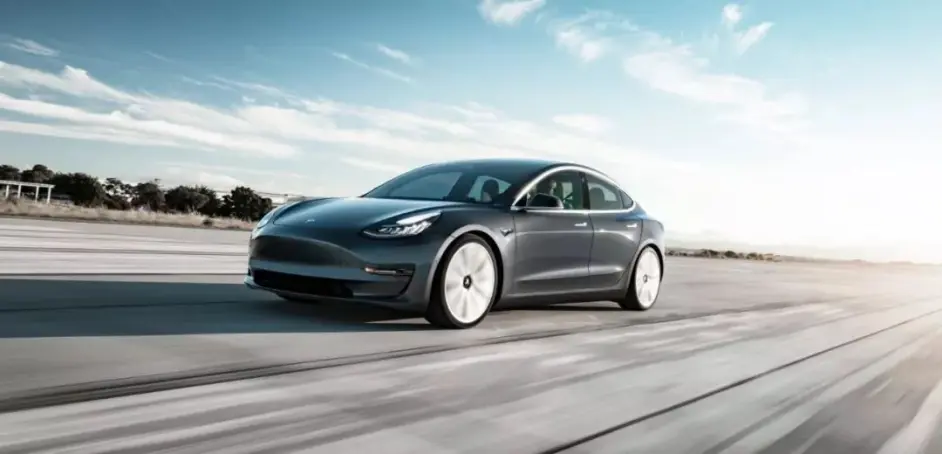On the morning of March 1st at 6:00 am Beijing time, Tesla CEO Elon Musk fulfilled his promise from the “Some Tesla news” teaser on February 27th with a big update that includes Model 3, Autopilot, and global sales and service system adjustments.
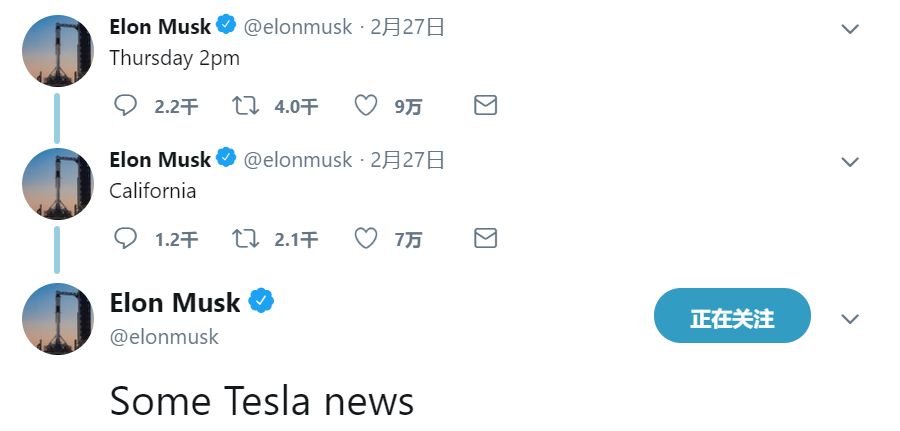
Here is a summary of the information:
- Tesla launched the standard range Model 3 priced at $35,000 and the standard plus Model 3 priced at $37,000.
- The Standard Range Model 3 provides an EPA-rated range of 354 km, a top speed of 209 km/h, and 0-96 km/h acceleration in 5.6 seconds.
- The Standard Plus Model 3 provides an EPA-rated range of 386 km, a top speed of 225 km/h, and 0-96 km/h acceleration in 5.3 seconds.
- Both new models have received NHTSA’s 5-star safety rating with the lowest probability of injury in its records, and an optional interior package upgrade priced at $2,500.
- The entire Model 3 lineup received performance upgrades via over-the-air updates, with the EPA range of the single motor rear-wheel-drive version reaching 523 km and the top speed of the Performance model reaching 260 km/h, and the output power of the entire Model 3 lineup increasing by 5%.
- The China market Model 3 received price reductions: the single-motor long-range version was reduced from 433,000 to 407,000 yuan, the dual-motor long-range version was reduced from 499,000 to 455,000 yuan, and the high-performance four-wheel-drive version was reduced from 560,000 to 516,000 yuan, with the decrease respectively being 2.6, 4.4, and 4.4 thousand yuan.
- Autopilot had a major adjustment: the price of Autopilot was reduced to $3,000, and the Full Self-Driving Capability was re-released at a price of $5,000.
- Full Self-Driving Capability includes Navigate on Autopilot (automatic driving on and off highways, automatic lane changing, and automatic passing), automatic parking (whether it’s perpendicular or parallel parking), summon (the vehicle drives from the parking lot to the owner), recognition and response to traffic lights and road signs, and city self-driving capability.* Sales and Service Policy Adjustments: In order to achieve better cost control, most Tesla stores in North America will gradually close and switch to online sales and cancel test drives. The corresponding Confidence Guarantee Program will be upgraded to 7 days or 1000 miles (1600 km). If owners are dissatisfied, they will receive a full refund unconditionally within this range. This plan will be extended to other global markets in the future.
- Increase investment in the Tesla service system and devote to responding to most demands and providing most services on the day when Tesla enters all countries/regions.
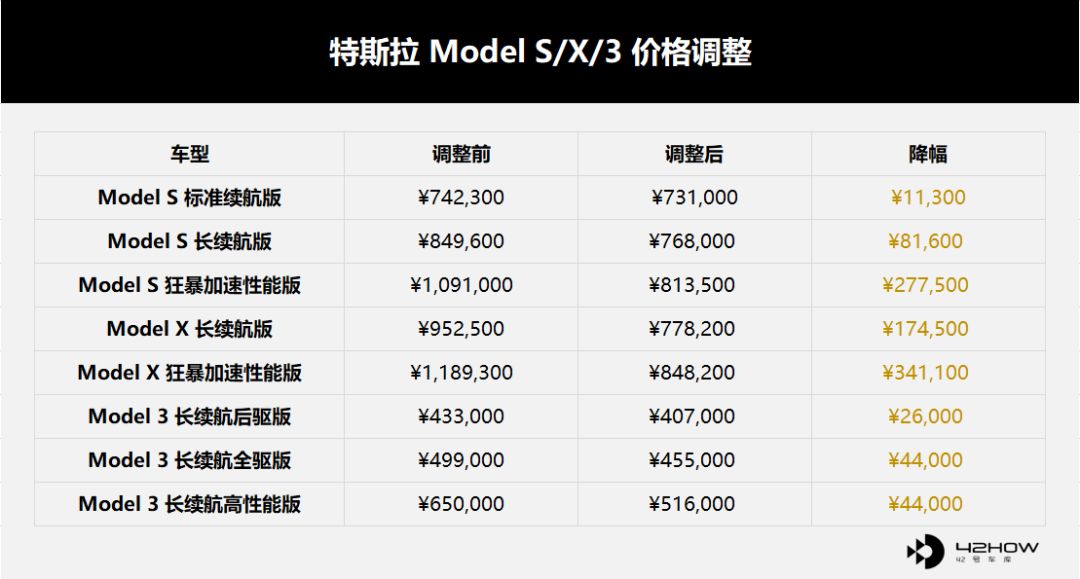
Next, let’s talk about what this major update means for Tesla and the industry.
Termination of Model 3 Project
Today is March 1, 2019, exactly 3 years since the release of the Model 3. Today, Tesla officially launched the Standard Model 3 with an EPA-rated range of 356 km, a 0-100 km/h acceleration of 5.6 seconds, and a starting price of $35,000.
Do you know what this means? Tesla has achieved the last target announced at the Model 3 launch event. To some extent, the Model 3 project has come to an end.
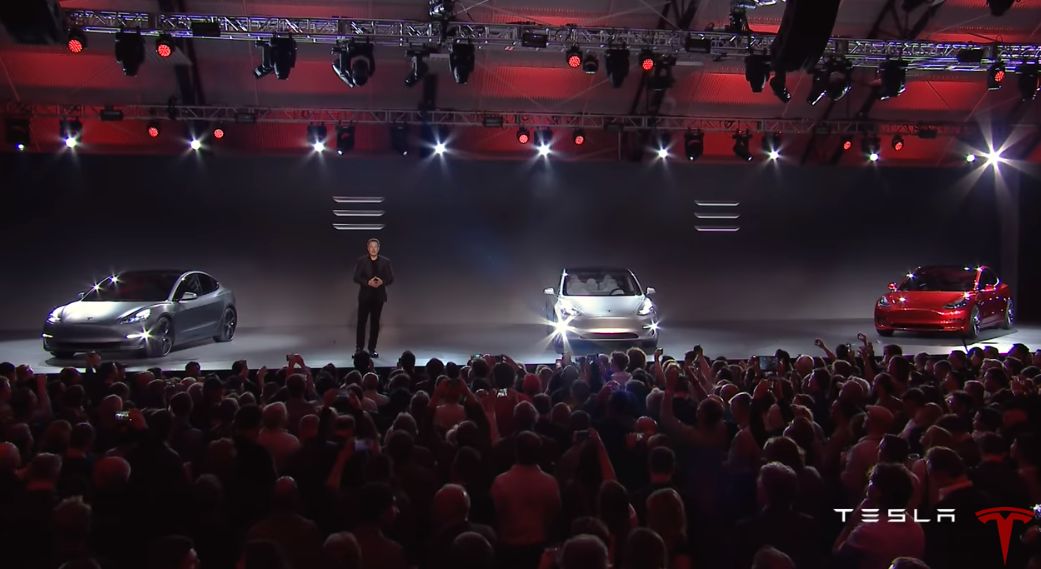
We have previously written in “Tesla’s Future” that in October 2015, one month after the Model X began delivery, most Tesla R&D engineers withdrew from the Model X project and joined the Model 3 project team.The production of the Model 3 Standard version means that all engineers will move on to the Model Y, the next-generation Model S/X, etc., leaving only capacity ramp-up, sales, delivery, and service. The Tesla team, which was deeply entrenched in production hell, has overcome the last challenge.
What sets the Model 3 project apart is that, compared to the Model S/X, Tesla has once again undertaken very aggressive technological, design, and engineering innovations within limited cost structures. At the same time, the Model 3 is Tesla’s first mid-size luxury car, which determines its market demand and production scale, which is completely different from that of the Model S/X.
In 2018, production capacity reached 5,000 vehicles per week.
After three years of countless difficult challenges, Tesla has finally gained the cost control, production, and delivery capabilities to launch the Model 3 Standard version.
This is a very difficult story, let’s follow the timeline.
In October 2018, Tesla first launched the unexpected Model 3 Mid Range version, as mentioned earlier, in addition to the Standard version, a Standard Plus version was also launched today at a price of $37,000.
Why was this “unplanned” model launched? According to Elon Musk’s original plan, the production sequence of the Model 3 High-Performance version, Long-Range version, and Standard version was carefully planned.
The High-Performance version has the best overall product strength and the highest gross profit margin. After selling a large number of high-performance models, obtaining more cash flow to expand production capacity and reduce costs, the Long-Range and Standard versions will be put into production one after another.
But in October 2018, something unexpected happened. The demand for the Model 3 High-Performance version in the North American market was saturated ahead of schedule, and the battery pack cost was still not enough to ensure that the Standard version would still have a reasonable gross profit margin when put into production.
Tesla had to release the Mid Range version with a cost and gross margin somewhere between the High-Performance and Standard versions as a transition, stimulating demand in the lower-end and larger-scale markets while further expanding production capacity and reducing costs.
In January 2019, Tesla began overseas deliveries ahead of schedule, but demand in China and Europe, the first and second largest overseas markets, for the Model 3 High-Performance version was far below expectations, and Tesla was facing its most difficult moment.### High-margin models aren’t selling, and low-priced models are losing money.
Elon Musk’s solution is to significantly cut Tesla’s physical stores, shift test drives to online sales, and thus greatly reduce operational costs, while also starting production ahead of schedule on the standard version of the Model 3.
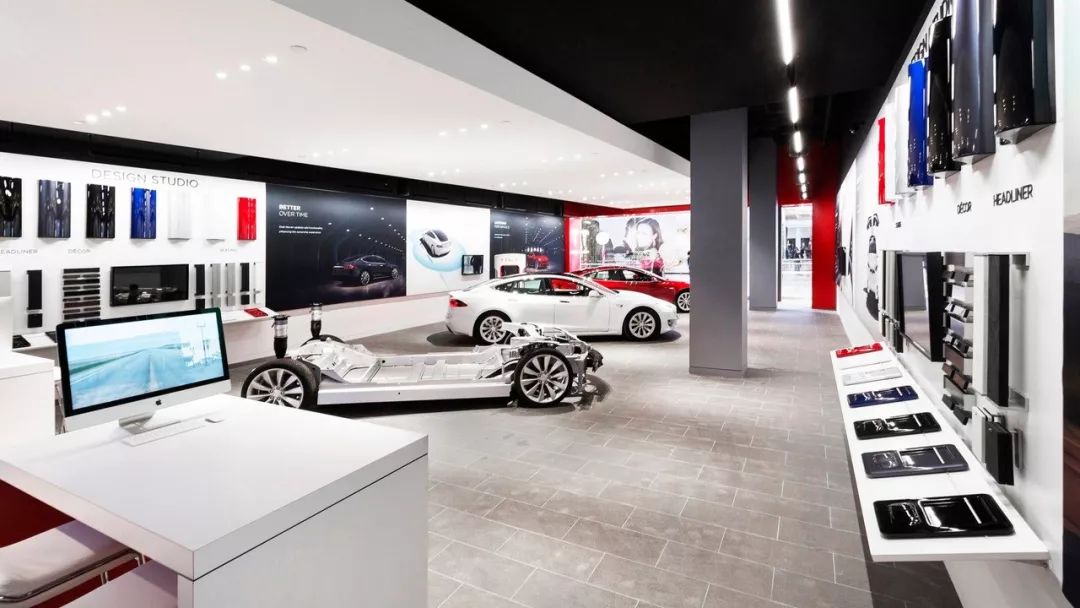
Throughout 2018, Elon Musk repeatedly told the media that it was Tesla’s most difficult year. What happened to the company in the past year?
-
Starting in mid-year, any spending over $1 million must be personally approved by Elon himself;
-
8,000 employees were laid off in two rounds of 9% and 7% cuts to control costs;
-
Several financial executives, including the CFO and VP of Finance, resigned.
The whole company was shrouded in the shadow of not making enough money to survive. As we enter 2019, the existing product mix still does not show strong market demand, so for Tesla to introduce the standard version, it must make changes.
Elon’s expertise is in the engineering and technical fields, but there have been problems in the Sales/Delivery/Service sector where he is not good at. So, how to solve this problem?
Lower the Prices! Lower the Prices! lower the Prices!
Today, the Chinese Model 3 market welcomed its fourth price cut.
-
Single-motor long-endurance: Reduced from 433,000 to 407,000
-
Dual-motor long-endurance: Reduced from 499,000 to 455,000
-
High-performance four-wheel drive: Reduced from 560,000 to 516,000
The price reductions were 26,000 yuan, 44,000 yuan, and 44,000 yuan, respectively. Stimulating market demand through price cuts is a rough but effective method.
Lowering the price of the high-performance version + starting production of the standard version + laying off the physical sales team + facing $1 billion of debt coming due – all show pressure on finance.

With all of this, after publicly committing to long-term profitability and having two consecutive profitable quarters, Elon once again admits that Tesla may fall into loss in Q1 2019.## Sales and Service Policy Adjustment
As previously mentioned, the production of the Standard Model 3 did not rely on reducing BOM and manufacturing costs, but on cutting the huge operating costs saved by dismantling the sales organization.
Online sales are not without problems. As cars are high-priced, low-frequency products, test drives are a crucial step before purchase. To address this issue, Tesla’s solution is to offer a 7-day or 1000-mile (1600km) confidence guarantee plan, within which owners can choose an unconditional refund if they are dissatisfied.
The reason for dismantling the sales organization is cost control and the pressure to produce the Standard Model 3, but prior to that, Tesla had already seen some factors that prompted sales to shift to online.
In July 2010, Elon poached George Blankenship from Apple to establish Tesla’s offline store network. In order to provide a high-quality in-store experience, Tesla product specialists use the number of test drives rather than order volume as a performance indicator. This is a signal: Tesla has full product confidence and believes that the vast majority of potential users will become owners after a test drive.
In 2018, Model 3 sales began to grow sharply, but due to cost control, Tesla’s store expansion was very restrained, with single-store sales growth reaching 300-400%. Behind the surge in sales, more than 50% of owners made payment directly without a test drive.
Since test drives are not necessary for everyone, can test drive, storefront operations, and related costs be compressed and replaced by confidence guarantee plans?
Tesla made it clear that this adjustment would expand from the United States to the world. After calculation, the operating costs saved by dismantling the sales organization and other sustained cost controls allow Tesla to lower the prices of all models by 6% (yes, Model S/X prices have also been reduced).
This is an extremely rational customer-centric sales strategy. When test drives are not absolutely necessary, then we cancel them. It will save operating expenses, and we choose to amortize them into product prices and give benefits to consumers.
Autopilot
Autopilot has undergone some major adjustments.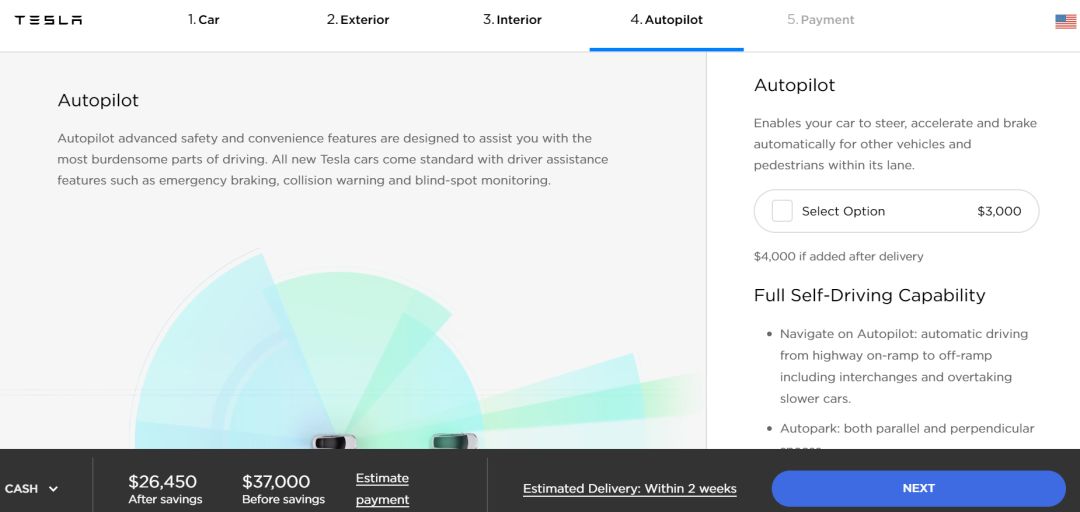
At the price level, Autopilot has been reduced to $3,000, and the Fully Self-Driving Capability package has been relaunched at a price of $5,000.
At the functional level, some of the functions that previously belonged to the Enhanced Autopilot have been included in the Fully Self-Driving Capability package.
Considering that some users previously installed the Enhanced Autopilot but did not install the Fully Self-Driving package, this adjustment has also caused some problems. The specific solution is still under discussion by the official, and is not elaborated here.
In October 2018, Tesla removed the Fully Self-Driving Capability option from its official website, causing numerous reports about Elon Musk’s apology.
Today, the Fully Self-Driving Capability package is back, but there are some new changes in its description.
For example, the US official website explicitly promises that “the car will be able to recognize and respond to traffic lights and stop signs”; “Navigate on Autopilot features — Autopilot automatic driving from highway on-ramp to off-ramp including interchanges and overtaking slower cars” will be available later this year. At the same time, there is a prompt in the Fully Self-Driving Capability option that “the currently enabled features require active driver supervision and do not make the vehicle autonomous”.
Tesla has never given up on its vision-based autonomous driving technology research and development. It has made adjustments to its descriptions to avoid misleading customers. In terms of functionality, the previous claim of autonomous driving across the United States, from California to New York, a distance of 4,500 km, has been abandoned, and has been replaced with more concrete recognition of traffic lights, recognition of road signs, and automatic assisted driving on city roads.
Regarding Elon’s announcement of achieving fully autonomous driving by the end of 2019, we are still not very hopeful. However, the AP team is gradually making progress from high-speed driving, automatic lane changing, to recognizing traffic lights and automatic assisted driving on city roads. Through a complete hardware and software solution, reasonable commercialization strategy, OTA updates, and data refining by the deep learning team, it is forming a data closed loop autonomous driving product.
From the perspective of growth potential, Autopilot has not had a real competitor so far.
Are you ready?
Tesla has reached its lowest point, how are others doing?
BBA (Mercedes-Benz, Audi, and BMW) had approximately 140,000 Model 3 orders in 2018, and today Tesla launched the Standard Plus model, which has an EPA range of 386 km, acceleration of 5.3 seconds for 0-100 km/h, and AP 2.5 assistive driving hardware. Even Elon himself said that the Standard Plus model with Autopilot is the best option for most people.
With the two tools of Standard and Standard Plus, Tesla is about to digest the remaining 200,000 orders. Don’t forget, this will promote Tesla to have larger production capacity, lower costs, and more advanced technological capabilities.
So, where is your Model 3? Is your first pure electric SUV production progressing smoothly?
Chinese new car companies, since the second half of 2018 to today, we have witnessed execution capabilities ten times or even a hundred times larger than that of new car-making Tesla, which is in no way inferior to any start-up company, in launching new car models in China.
Ignoring the leading position in technology, in the face of weak market demand, Tesla has shown very strong organizational resilience. Adhering to direct sales allows Tesla to directly control the global online and offline sales organization, and support timely adjustments to meet the needs of business development.
With this flexible organizational structure, adaptive execution capability, and leading comprehensive product strength, how much confidence do you have to face the challenge?
Touching the bottom, only rebounding. Elon’s survival philosophy is very simple: Peace was never an option.
After today’s adjustment, the Model 3 is coming to an end; Autopilot is starting to attack; the engineering and research and development teams have moved to a new project group. Don’t forget, the Model Y is already in sight.
Elon Musk fired, can you dodge it?


-
Elon Musk arrives in Shanghai, and the catfish enters China* Elon Musk: If there is an electric car that can force Tesla to close down, it is still a good thing for the world.

This article is a translation by ChatGPT of a Chinese report from 42HOW. If you have any questions about it, please email bd@42how.com.
